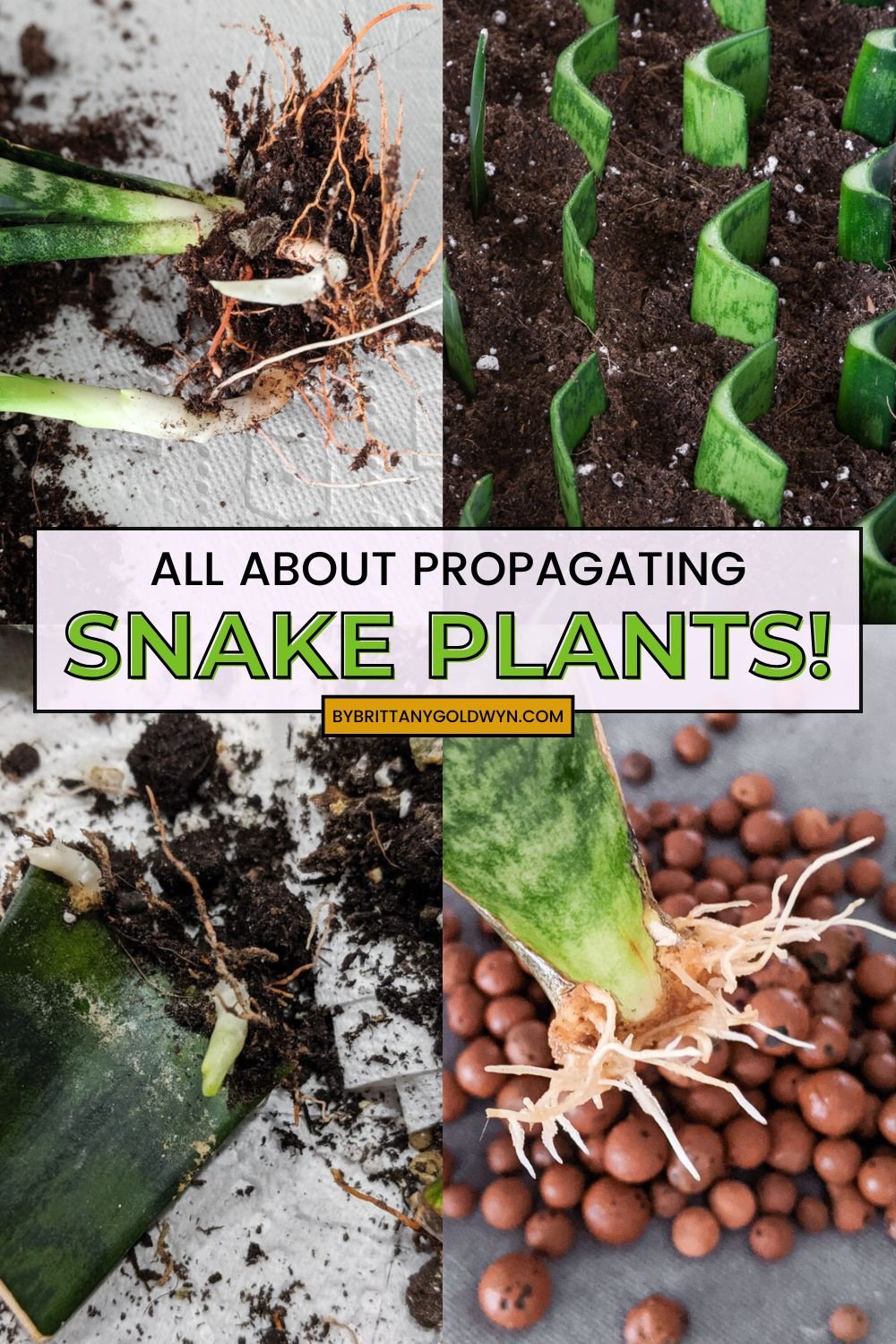5 easy ways to root snake plant cuttings!
Hey all, this guide is a follow-on to my how to care for your snake plant article! Now that you have all of the care tips, let’s talk about how to propagate snake plants. I love snake plants, so why wouldn’t I want to grow more? After all, I’ve owned 18 Sansevieria varieties you can check out here!
And snake plants are one of the absolute best plants to propagate. It’s easy, and there are five different ways to do so that I’ll cover in this guide: by rhizome, by division, by cuttings rooted in well-draining soil, by cuttings rooted in water, and by leaf cuttings in LECA.

–Overview–
Rhizome: Remove the rhizome, a root-like structure, from the mother plant. Allow the cutting to dry for a day to regulate water intake. Plant in soil and water as normal.
Division: Ideal for large plants. Take the plant out of its pot and gently remove the soil around the rootball; use a clean knife to separate a pup (baby plant) from the mother plant at the rhizome. Let callus over for a day and plant.
Water: Take a cutting of a single leaf; let it callus over for a day and then put it in water. Monitor root development and plant when roots are several inches long.
LECA: Take a cutting of a single leaf; let it callus over for a day and then put it in a jar with LECA and a water reservoir. Refill the reservoir as needed; plant when roots are several inches long.
Soil: Take a leaf cutting or cut a leaf into multiple pieces; allow them to callus over, then plant in well-draining soil. Keep moist and monitor for new growth.

1. Via rhizomes
Rhizomes are the whiteish root-like stem structures that connect the mother plant to its pups, or “babies.” The rhizomes spread just above or below ground and sprout new plants.
To propagate a snake plant by its rhizome:
- Use a clean knife to cut off the rhizome from the plant it’s growing off of.
- Let the rhizome dry out for a day or so; this is to help the cut area harden over to better regulate water intake.
- Plant in well-draining soil.
- Keep the freshly planted rhizome moist for a few weeks until you see new growth above the soil’s surface.
I’ve taken a few pics of a small rhizome starting to sprout from the mother plant below—the first two photos. They kind of remind me of garlic at this point. The last photo shows what those rhizomes will look like when they start sprouting back up through the soil.



2. By division
Another way to propagate a snake plant is by division. This is similar to propagating it by rhizome. Snake plants reproduce by growing pups or babies—what sprouts from those rhizomes under the surface. These eventually become their own plants that you can cut off of the mother plant and pot separately.
Here’s how to propagate by division:
- Take the plant out of the pot and gently brush away the soil from the root system.
- Find the rhizome connecting two snake plants.
- Using a clean sharp knife or scissors, cut right in the middle of the rhizome to separate the plants.
- Let the callus over for 24 hours to help regulate water intake, then plant in fresh soil.
In the pics below, you’ll see very clearly what I mean with these steps. The main plant begins sprouting rhizomes, and the rhizomes eventually sprout and turn into new plant babies.



3. In water
While water propagation is probably the easiest propagation method—because it only uses water—it also takes the longest. And, honestly, it seems to produce the weakest results from my experience. It doesn’t not work, but it isn’t my favorite method.
Here’s how it works:
- Cut a leaf down near the soil; let it callus over for about 24 hours to help the cutting regulate water intake.
- Put it in water; refresh the water weekly and monitor for root growth.
- Plant in soil with roots begin to sprout and keep evenly moist.
If you don’t see roots after several weeks and the end of your leaves are beginning to get brown and mushy, water rooting might not be working out. I had this happen recently with a whale fin snake plant (masoniana) leaf cutting I was trying to root in water (see below).
Water rooting is hit or miss with snake plants. If you have an extra leaf you snipped off for whatever reason, why not try it?! Water is free, and you can root the cutting in almost anything. Just don’t be heartbroken if it doesn’t work out.

4. With LECA
LECA is an excellent alternative to water rooting. I’m a huge fan of rooting propagations in LECA since the medium provides a lot of the ease (and visibility) or water rooting along with the strength of roots grown in soil.
If you have no idea what LECA is, check out my guide all about how to root cuttings in LECA. In a nutshell, they are clay balls that hold moisture. Here’s how to propagate a snake plant cutting in LECA:
- Rinse your LECA thoroughly and put a layer in the bottom of a container.
- Add the leaf cutting in and fill in around it with LECA for stability.
- Add water to the bottom of the jar—just enough to create a reservoir under the cutting.
- Monitor for root growth; transfer to soil when the roots are a few inches long.
Check out the explosion in root growth we got after a few weeks in LECA! I gasped when I dumped all of the water and LECA out to see these roots.



5. In soil
Propagating snake plants using a single cut leaf can also be done in soil. This can be really interesting, too, because you can chop up a leaf into pieces and propagate each of those cuttings individually!
Here are the steps:
- Take a leaf cutting and cut it into several smaller pieces; keep track of which ends are the bottoms and should be planted in the soil.
- Let the pieces callus over for a few days.
- Plant each cutting with the bottom end down in well-draining soil.
- Keep the soil moist until you see new growth emerge from the soil.
It can take a month or so to root and then another couple of months or more to get new leaf growth above the surface of the soil. You can’t see anything going on under the surface of the soil, so it feels like it takes forever.
The leaf cutting itself won’t grow. What will happen is that the cutting will sprout roots below the surface. Eventually those roots will grow a rhizome, and it’s that rhizome that will then produce an actual snake plant.




Wrapping up…
Now that you know all the different ways to propagate snake plants, you can fill every room in your house with them for free! Snake plants are some of my favorites, so propagating them is definitely near and dear to my heart. I hope you have success propagating your snake plants!
Pin my tips!


Brittany is a seasoned DIY home and garden expert, running a creative brand since 2014 that inspires others with approachable plant care guides, sustainable gardening how-tos, and DIY projects. She is a master gardener and certified project manager who has completed extensive coursework in the art and science of growing your own plants. Her favorite thing to do is inspire you! Learn more about her here.

Thanks for the full and useful explanation.
You got it. Thanks for stopping by!